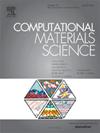PBXs中空洞-脱键协同作用介导的热点形成机制:多场耦合晶格弹簧模型研究
IF 3.3
3区 材料科学
Q2 MATERIALS SCIENCE, MULTIDISCIPLINARY
引用次数: 0
摘要
准确预测聚合物粘结炸药(PBXs)的冲击-爆轰过渡(SDT)需要了解多机制热点的形成。为了解决这个问题,我们开发了一种新的机械-热-化学耦合晶格-弹簧模型(MTC-LSM),该模型明确地集成了损伤演化(界面脱键、晶体/粘结剂断裂)、局部热生成(摩擦、空隙坍塌)和初始反应。该框架能够同步模拟冲击载荷下的损伤进程和温度演变。该模型成功地捕获了主pbx的损伤特征。对于无孔pbx,模拟结果表明,随着冲击速度的增加,脱粘过程向晶体断裂发展。在较低的撞击速度下,会发生损坏,但温度仍然是亚临界的。较高的冲击速度加强了粘结剂-晶体的脱键相互作用,导致界面温度急剧上升,有利于热点的形成。在多孔PBX中,仅在中等冲击速度下,孔隙坍塌就会产生亚临界温度。然而,在明显更高的冲击速度下,协同空洞坍塌和脱粘增强了空洞-界面耦合,产生明显的温度峰值。这种对空隙脱粘协同作用的机理理解为热点地层物理提供了新的见解,为PBX设计中抑制着火风险提供了关键指导。本文章由计算机程序翻译,如有差异,请以英文原文为准。

Mechanism of void-debonding synergy mediated hotspot formation in PBXs: A multifield-coupled lattice spring model study
Accurate prediction of shock-to-detonation transition (SDT) in polymer-bonded explosives (PBXs) requires an understanding of multi-mechanism hotspot formation. To address this, we developed a novel mechanical-thermal-chemical coupled lattice-spring model (MTC-LSM) that explicitly integrates damage evolution (interfacial debonding, crystal/binder fracture), localized heat generation (friction, void collapse), and incipient reactions. This framework enables synchronized simulation of damage progression and temperature evolution under impact loading. The model successfully captures the primary PBXs damage characteristics. For non-porous PBXs, simulations show debonding progresses to crystal fracture with increasing impact velocity. At lower impact velocities, damage occurs but temperatures remain subcritical. Higher impact velocities intensify binder-crystal debonding interactions, inducing sharp interfacial temperature rises conducive to hotspot formation. In porous PBX, void collapse alone at moderate impact velocities generates subcritical temperatures. However, at significantly higher impact velocities, synergistic void collapse and debonding enhance void-interface coupling, producing pronounced temperature spikes. This mechanistic understanding of void-debonding synergy provides new insights into hotspot formation physics, offering critical guidance for suppressing ignition risks in PBX design.
求助全文
通过发布文献求助,成功后即可免费获取论文全文。
去求助
来源期刊

Computational Materials Science
工程技术-材料科学:综合
CiteScore
6.50
自引率
6.10%
发文量
665
审稿时长
26 days
期刊介绍:
The goal of Computational Materials Science is to report on results that provide new or unique insights into, or significantly expand our understanding of, the properties of materials or phenomena associated with their design, synthesis, processing, characterization, and utilization. To be relevant to the journal, the results should be applied or applicable to specific material systems that are discussed within the submission.
 求助内容:
求助内容: 应助结果提醒方式:
应助结果提醒方式:


